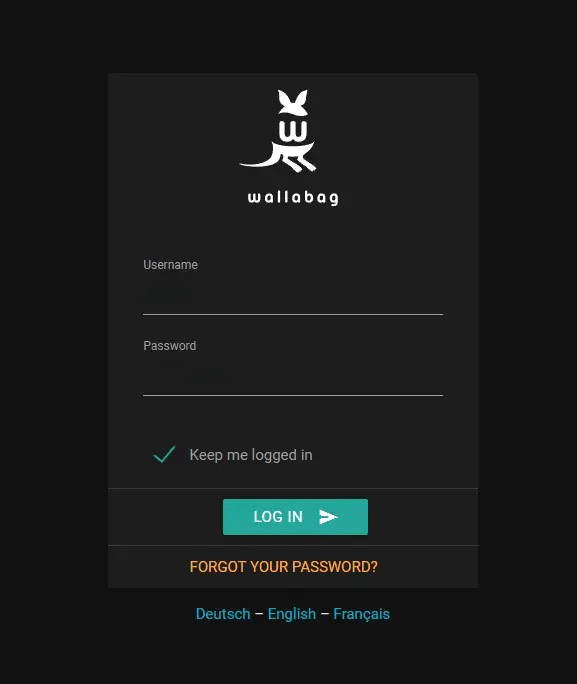How To Install Wallabag on Debian 12

In this tutorial, we will show you how to install Wallabag on Debian 12. Tired of losing track of interesting articles online? Need a reliable way to save web content for later reading? Wallabag provides an excellent self-hosted solution that gives you full control over your read-it-later content. This comprehensive guide will walk you through installing Wallabag on Debian 12, from initial setup to final configuration and maintenance.
What is Wallabag?
Wallabag is an open-source, self-hosted application that allows you to save web pages for later reading. Unlike proprietary services such as Pocket or Instapaper, Wallabag gives you complete ownership of your data and reading list. When you save an article with Wallabag, the content is stored on your own server, ensuring you can access it even if the original website goes offline.
Key features of Wallabag include:
- Clean reading experience without ads or distractions
- Cross-platform availability (web, mobile, browser extensions)
- Content tagging and organization capabilities
- Full-text search functionality
- Offline reading support
- Article sharing options
- API for integrations with other services
- Import capabilities from other read-it-later services
Wallabag extracts the core content from web pages, preserving images and formatting while eliminating distracting elements. This results in a clean, focused reading experience across any device.
Prerequisites for Installing Wallabag
Before beginning the installation process, ensure you have the following prerequisites in place:
- A server running Debian 12 with at least 1GB RAM and 10GB storage
- Root access or a user with sudo privileges
- A registered domain name (if you want to access Wallabag remotely)
- Basic command-line knowledge
- SSH access to your server
- Properly configured firewall with ports 80 and 443 open
It’s recommended to start with a fresh Debian 12 installation to prevent potential conflicts with existing configurations.
Preparing Your Debian 12 System
Update System Packages
The first step is to update your system packages to ensure you have the latest versions and security patches:
sudo apt update && sudo apt upgradeInstall Essential Utilities
Install necessary utility packages that will be required throughout the installation process:
sudo apt install wget curl nano software-properties-common dirmngr apt-transport-https gnupg2 ca-certificates lsb-release ubuntu-keyring unzip git makeSet Up a Non-Root User with Sudo Privileges
If you’re logging in as root, it’s good practice to create a dedicated user for administration:
adduser username
usermod -aG sudo usernameReplace “username” with your preferred username.
Installing Required Dependencies
Wallabag requires several components to function properly, including a web server, PHP with specific extensions, and a database. Let’s install these dependencies one by one.
PHP Installation
Wallabag requires PHP 8.1 or higher with several extensions. Install PHP and the required extensions with:
sudo apt install php-fpm php-mysql php-bcmath php-xml php-zip php-curl php-mbstring php-gd php-tidy php-tokenizer php-cli php-dom php-jsonVerify the PHP installation by checking the version:
php -vChoosing and Installing a Web Server
You can use either Apache or Nginx as your web server. This guide will cover both options.
Option 1: Apache Installation
sudo apt install apache2 libapache2-mod-phpEnable necessary Apache modules:
sudo a2enmod rewrite
sudo a2enmod ssl
sudo systemctl restart apache2Option 2: Nginx Installation
sudo apt install nginxAfter installing Nginx, you’ll need to configure PHP-FPM to work with it:
sudo apt install php-fpm
sudo systemctl enable php-fpm
sudo systemctl start php-fpmInstalling Composer
Composer is a dependency management tool for PHP and is required for Wallabag installation:
php -r "copy('https://getcomposer.org/installer', 'composer-setup.php');"
php composer-setup.php --2.2
php -r "unlink('composer-setup.php');"
sudo mv composer.phar /usr/local/bin/composerVerify the installation:
composer --versionNote that Wallabag works best with Composer 2.2 LTS, which is why we specified that version during installation.
Database Setup
Wallabag supports multiple database systems. You can choose between MySQL/MariaDB and SQLite depending on your needs.
Option 1: MySQL/MariaDB Installation
sudo apt install mysql-serverSecure the MySQL installation:
sudo mysql_secure_installationCreate a database and user for Wallabag:
sudo mysql -u root -pAt the MySQL prompt, execute:
CREATE DATABASE wallabag;
CREATE USER 'wallabag'@'localhost' IDENTIFIED BY 'your_secure_password';
GRANT ALL PRIVILEGES ON wallabag.* TO 'wallabag'@'localhost';
FLUSH PRIVILEGES;
EXIT;Option 2: SQLite Configuration
If you prefer SQLite, which is simpler to set up but less suitable for high-traffic installations:
sudo apt install sqlite3 php-sqlite3SQLite doesn’t require user creation or specific configuration, as it stores data in a file that Wallabag will manage.
Web Server Configuration
Apache Configuration
If you chose Apache, create a virtual host configuration file:
sudo nano /etc/apache2/sites-available/wallabag.confAdd the following content, replacing “wallabag.example.com” with your domain:
<VirtualHost *:80>
ServerAdmin admin@example.com
ServerName wallabag.example.com
DocumentRoot /var/www/html/wallabag/web
<Directory /var/www/html/wallabag/web>
AllowOverride All
Require all granted
</Directory>
ErrorLog ${APACHE_LOG_DIR}/wallabag_error.log
CustomLog ${APACHE_LOG_DIR}/wallabag_access.log combined
RewriteEngine on
RewriteCond %{SERVER_NAME} =wallabag.example.com
RewriteRule ^ https://%{SERVER_NAME}%{REQUEST_URI} [END,NE,R=permanent]
</VirtualHost>Enable the site and disable the default site:
sudo a2dissite 000-default.conf
sudo a2ensite wallabag.conf
sudo systemctl restart apache2Nginx Configuration
If you chose Nginx, create a server block configuration:
sudo mkdir -p /var/www/wallabag.example.com/{public_html,logs}
sudo nano /etc/nginx/sites-available/wallabagAdd the following content, replacing “wallabag.example.com” with your domain:
server {
server_name wallabag.example.com;
root /var/www/html/wallabag/web;
access_log /var/log/nginx/wallabag_access.log;
error_log /var/log/nginx/wallabag_error.log;
location / {
try_files $uri /app.php$is_args$args;
}
location ~ ^/app\.php(/|$) {
fastcgi_pass unix:/run/php/php8.2-fpm.sock;
fastcgi_split_path_info ^(.+\.php)(/.*)$;
include fastcgi_params;
fastcgi_param SCRIPT_FILENAME $realpath_root$fastcgi_script_name;
fastcgi_param DOCUMENT_ROOT $realpath_root;
internal;
}
}Enable the site:
sudo ln -s /etc/nginx/sites-available/wallabag /etc/nginx/sites-enabled/
sudo systemctl restart nginxSSL/TLS Certificate Setup
Secure your Wallabag installation with HTTPS by obtaining a free SSL certificate from Let’s Encrypt:
Installing Certbot
sudo apt install certbotFor Apache:
sudo apt install python3-certbot-apache
sudo certbot --apache -d wallabag.example.comFor Nginx:
sudo apt install python3-certbot-nginx
sudo certbot --nginx -d wallabag.example.comFollow the prompts to complete the SSL configuration process. Certbot will automatically configure your web server to use HTTPS and set up certificate auto-renewal.
Downloading and Installing Wallabag
There are two methods to obtain Wallabag: direct download or Git repository cloning.
Method 1: Direct Download
sudo mkdir -p /var/www/html/wallabag
cd /var/www/html
sudo wget https://wllbg.org/latest-v2-package -O wallabag.zip
sudo unzip wallabag.zip -d /var/www/html/
sudo mv wallabag-*/* /var/www/html/wallabag/
sudo mkdir -p /var/www/html/wallabag/data/assetsMethod 2: Git Repository Cloning
sudo git clone https://github.com/wallabag/wallabag.git /var/www/html/wallabagSetting Proper Permissions
Change the ownership of the Wallabag directory to the web server user:
sudo chown -R www-data:www-data /var/www/html/wallabagFor development or easier management, you might want to set your current user as the owner:
sudo chown -R $USER:$USER /var/www/html/wallabagConfiguring Wallabag
Creating the Parameters File
Create the configuration file by copying the template:
cd /var/www/html/wallabag
cp app/config/parameters.yml.dist app/config/parameters.yml
nano app/config/parameters.ymlGenerating a Secret Key
Generate a secure secret key:
openssl rand -base64 32Configuring Parameters
Edit the parameters.yml file with your specific configuration. Here’s a sample configuration for SQLite:
parameters:
database_driver: pdo_sqlite
database_host: 127.0.0.1
database_port: ~
database_name: wallabag
database_user: ~
database_password: ~
database_path: '%kernel.project_dir%/data/db/wallabag.sqlite'
database_table_prefix: wallabag_
database_socket: ~
database_charset: utf8mb4
mailer_transport: smtp
mailer_host: 127.0.0.1
mailer_user: ~
mailer_password: ~
locale: en
secret: YOUR_GENERATED_SECRET
# Domain name used in emails sent by Wallabag
domain_name: 'https://wallabag.example.com'
# Two-factor authentication
twofactor_auth: false
twofactor_sender: no-reply@wallabag.org
# User registration settings
fosuser_registration: true
fosuser_confirmation: true
# RSS settings
rss_limit: 50
# Optional Redis configuration
redis_scheme: tcp
redis_host: localhost
redis_port: 6379
redis_path: ~
redis_password: ~Replace ‘YOUR_GENERATED_SECRET’ with the secret key you generated earlier, and adjust other parameters as needed.
Running the Installation Process
Now that you’ve configured Wallabag, you can run the installation process:
Using Make (Recommended)
If you have Make installed:
cd /var/www/html/wallabag
sudo -u www-data make installThe installer will check your system requirements, set up the database, and guide you through creating an admin user.
Alternative Installation Method
If you don’t have Make installed, you can run these commands:
cd /var/www/html/wallabag
sudo -u www-data composer install --no-dev -o
sudo -u www-data php bin/console wallabag:installDuring the installation process, you’ll be prompted to:
1. Confirm your database configuration
2. Reset the database if it already exists
3. Create an admin user (username, password, and email)
Post-Installation Configuration
Setting Up Cron Jobs for Background Tasks
For optimal performance, set up a cron job to process background tasks:
sudo crontab -eAdd the following line to run import tasks every hour:
0 * * * * /usr/bin/php /var/www/html/wallabag/bin/console wallabag:import:redis-worker --env=prod >> /var/log/wallabag-import.log 2>&1Configuring Cache Management
For better performance, consider setting up Redis for caching:
sudo apt install redis-server php-redis
sudo systemctl enable redis-server
sudo systemctl start redis-serverThen update your parameters.yml file to include the Redis configuration.
Testing Your Wallabag Installation
You can now access your Wallabag instance by navigating to your domain in a web browser:
https://wallabag.example.comThe first time you access the site, you’ll be prompted to log in with the admin account you created during installation.

Verifying Functionality
Try saving an article by:
1. Clicking “New entry” in the top navigation bar
2. Entering a URL in the field provided
3. Clicking “Save”
The article should be retrieved, parsed, and saved to your Wallabag instance.
Setting Up Browser Extensions
To make the most of Wallabag, install browser extensions that facilitate saving articles:
– Firefox: Wallabagger for Firefox
– Chrome: Wallabagger for Chrome
Configuring Mobile Apps
Wallabag offers mobile apps for both Android and iOS. To configure them:
1. Download the app from your device’s app store
2. Enter your Wallabag URL
3. Provide your login credentials
4. For API access, generate a client ID and secret in your Wallabag account settings
Security Considerations
Keeping Wallabag Updated
Regularly check for updates and upgrade your Wallabag installation:
cd /var/www/html/wallabag
git pull
sudo -u www-data make updateWeb Server Security Hardening
For Apache:
sudo a2enmod headers
sudo systemctl restart apache2For Nginx, ensure your server block includes security headers:
add_header X-Frame-Options "SAMEORIGIN";
add_header X-XSS-Protection "1; mode=block";
add_header X-Content-Type-Options "nosniff";Firewall Configuration
Set up a firewall to protect your server:
sudo apt install ufw
sudo ufw allow ssh
sudo ufw allow http
sudo ufw allow https
sudo ufw enableMaintenance and Updates
Backup Strategy
Regularly back up your Wallabag data:
# For SQLite
cp /var/www/html/wallabag/data/db/wallabag.sqlite /backup/wallabag_$(date +%Y%m%d).sqlite
# For MySQL
mysqldump -u root -p wallabag > /backup/wallabag_$(date +%Y%m%d).sqlLog Management
Monitor Wallabag logs for issues:
tail -f /var/log/apache2/wallabag_error.log
# or for Nginx
tail -f /var/log/nginx/wallabag_error.logPerformance Monitoring
Check PHP-FPM status:
systemctl status php8.2-fpmMonitor system resources:
htopTroubleshooting Common Issues
Permission Problems
If you encounter permission issues, ensure proper ownership:
sudo chown -R www-data:www-data /var/www/html/wallabag
sudo chmod -R 755 /var/www/html/wallabagDatabase Connection Issues
For MySQL connection problems:
1. Verify database credentials in parameters.yml
2. Check that the MySQL service is running: systemctl status mysql
3. Test database connection: mysql -u wallabag -p wallabag
PHP Extension Errors
If the installer reports missing PHP extensions:
sudo apt install php-mbstring php-gd php-xml php-curl php-zip php-tidy
sudo systemctl restart php8.2-fpmFor Apache with mod_php:
sudo systemctl restart apache2Web Server Configuration Errors
For Apache errors, check:
sudo apachectl configtestFor Nginx errors, check:
sudo nginx -tCongratulations! You have successfully installed Wallabag. Thanks for using this tutorial for installing Wallabag on Debian 12 “Bookworm” system. For additional help or useful information, we recommend you check the Wallabag website.